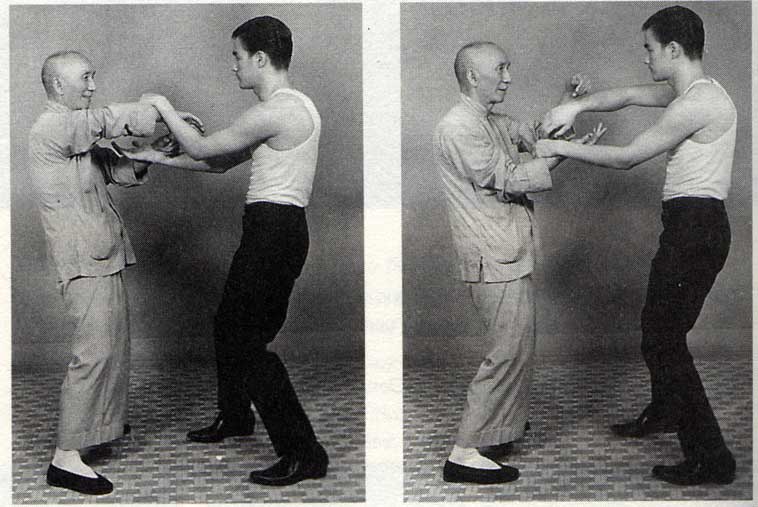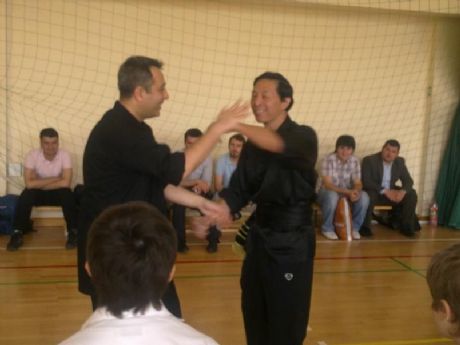
 Chi Sao (sticking hands) training is a signature component of Wing-Chun Kung-Fu. Chi-Sao allows the practitioner to integrate various aspects of the Wing-Chun system. It is first and foremost an energetic sensitivity exercise. Through prescribed arm positions, structure and movement you can begin to attune to the energy of your training partner. You begin to focus and sense the energy (chi). The connection through the arm contact is the portal wherein each person learns how to deeply sense and feel movement, tension and energy from your partner.
Chi Sao (sticking hands) training is a signature component of Wing-Chun Kung-Fu. Chi-Sao allows the practitioner to integrate various aspects of the Wing-Chun system. It is first and foremost an energetic sensitivity exercise. Through prescribed arm positions, structure and movement you can begin to attune to the energy of your training partner. You begin to focus and sense the energy (chi). The connection through the arm contact is the portal wherein each person learns how to deeply sense and feel movement, tension and energy from your partner.
The Sticking Hands
Chi-Sao is a unique tool that Wing-Chun has to offer. It is the very "heart and soul" of the Yip-Man Wing-Chun system, “No Chi-Sao, No Wing-Chun” as grandmaster Yip-Man said. Chi-Sao training develops timing and contact reflexes. Many Chi-Sao techniques do not apply to actual fighting; however having trained in these Wing-Chun Chi-Sao, the practitioner will develop the fundamental skill of contact reflexes which is the key to victory in fighting. The other benefits of Chi-Sao are close distance coordination, focusing with the eyes, mobility, balance, timing, accuracy, control of the opponent's balance, and Chi-Gong power. The training process is briefly described as follow:
1. One arm Chi-Sao (Dan-Chi-Sao/Yee Chi Kim Yeung Ma) 2. Lop Sau (Yee Chi Kim Yeung Ma/Chuen Ma) 3. Moving one arm Chi-Sao with the coordination of footwork 4. Two arms Chi-Sao (Yee Chi Kim Yeung Ma/Progression) 5. Moving two arms Chi-Sao with progressions and coordination of footwork 6. Free two arms Chi-Sao both on the ground and on the 9 pole-plum-flower-Jong. And Blinded Fold Chi-Sao.
Naturally, the right side of the human brain controls the left side of the body, and the left side of the brain controls the right side of the body. Therefore, Chi-Sao trains both sides of the human brain to minimize the thinking process and enables your hands to deflect and redirect the opponent’s attack. The student learns how to use both arms interdependently. Chi-Sao is a specialized method of training which develops touch or contact reflexes and coordination of the limbs, while improving balance, close range focus of the eyes, and developing internal energy for striking at close range. It improves footwork for close range mobility, accuracy for striking, and the ability to control an opponent's balance from the point of contact with forward energy.
Rather than sparring, Chi-Sao gives two practitioners the opportunity to test and explore each other's strengths and weaknesses, allowing a unique and unplanned learning process to take place. Chi-Sao helps to hone footwork coordination, reflexes, positioning, techniques, energy and the automatic response to any situation, for which Wing-Chun has become the subject of legend.
Relaxation in the forearm creates an advantage in Chi-Sao. The practitioner does not have to consciously think, as the arm is automatically guided to form each successive structure. All of the Wing-Chun techniques learnt in the forms need to be progressively and systematically drilled in combat-realistic fashion, first against cooperative and then against uncooperative partners in both Chi-Sao and free sparring. Chi-Sao is the bridge that links all the hand-positioning techniques from all Wing-Chun forms into one infinite chain of techniques that is very difficult to defeat.
Chi-Sao in essence teaches and ingrains into the neuro-muscular system the Wing-Chun mindset of accepting and sticking with the attack, staying with the attacking limb as it returns and striking along an open path when the hand is free.
Wing-Chun practitioners often have the misconception that Chi-Sao is the same as fighting. But this is not the case..Chi-Sao is a learning and honing process, whereas fighting is about winning and losing, about countering strikes and knocking someone down. When one can not distinguish the difference between Chi-Sao and fighting, then trouble arises. Hence the question that ought to be posed to the Wing Chun practitioner is not: “How good are you at Chi-Sao?” Many folks don’t truly understand the purpose of Chi-Sao training and mistakenly believe that if they engage in Chi-Sao with practitioners from other schools, this will indicate who is the better fighter.
The word 'partner' is emphasized, because Chi-Sao must be done cooperatively if there is to be proper learning about energetic sensitivity. In the beginning of chi sau training, the movements must be done in a slow and relaxed manner, to allow the body to learn how to sense and feel energy. In doing chi sau this way, you can set an intention to “pay attention” to sensation and energy on a subtle level. If Chi-Sao is done quickly and aggressively without cooperation, the body learns to become tense, rigid and insensitive. The body reacts to fear or anger instead of learning how to respond with proper technique and energy in an intentionally relaxed manner. Remember, the more relaxed the practitioner is, the more he/she will be able to develop speed and power.
Once a basic foundation of proper technique, structure and energetic sensitivity has been laid, you can slowly start to integrate a variety of hand strikes, blocks, and trapping techniques. Again, this needs to be done in a cooperative manner where each person intentionally assists his or her partner by taking turns feeding energy (initiating techniques) to the other and allowing the other to respond properly in a calm manner. Soon, the practitioners’ energy begins to flow between them, almost like dancers, where one person leads and the other follows. Through this prescribed mode of “playing chi sau”, your ability to respond becomes quicker and more powerful as your body has been allowed to learn progressively under ideal training conditions.
Chi-Sao training can now progress to include shifting, stepping and coordinating the flow, exchange and release of full body energy. At this level, all chi sau movement and energy originates from the daan tin, or qi storage area, located just below the navel of the body. Through the initiation of leg and hip movements and coordinated with breath, the qi is moved from the core of the body to flow outwards. The chi is released in a direct and focused way through strikes, blocks, kicks or traps. In this way, the qi is radiated from the core of the body towards the extremities (hands, feet) and is then gathered back up into the core, via breath and relaxed muscles. The qi is again ready to flow and be released at lightning speed with maximum power and effect. This oscillation of “relaxation and release” is the ideal state of being when practicing chi sau. With the exception of a strike, when we release qi we train to use the least amount of energy required to accomplish our goal. Our goal, via blocks or traps, is to control the centre line of the partner. We want to use the least amount of energy because it is consistent with the Wing-Chun principle of efficiency and when we use less to achieve more, our ability to maintain sensitivity is at an optimal level. Even as we train to block, trap and eventually strike we want to maintain our ability to sense and perceive changes in our partner’s energy and movements. This is so we may be able to further adapt to our partner’s attempts to avoid being controlled on the centerline. Only when we know that there is no escaping our dominance of the centerline, we can know that we can hit at will. In chi sau there is no need to hit your partner. You know you could if this were a real self-defense situation. Chi-Sao is not combat, it is a training technique to prepare you for combat.
If you practice chi sau aggressively, with little sensitivity and control, and no cooperation, you are no longer training chi sau. You are now training your ego and pride. Under these less than ideal conditions, skill development is arrested. Further, your partner will become demoralized and tired. It is not pleasurable to be hit and to use aggressive energy in chi sau. You will deplete your qi, muscles will become sore and tired, sensitivity will become numbed and your spirit will suffer. Your Kung Fu training will stagnate and you will likely give up training, thinking that you have learned all there is to know about chi sau. Chi-Sao, when practiced properly, will offer a lifetime of learning. There are no limits to how energetically sensitive you can become.
There is a time, place and means to train with more “realistic” self-defense energy within the Wing-Chun system. This comes only after much training, discipline, control and skill development. Training with this self-defense energy should only be done when there is a solid base of integrated Wing-Chun knowledge and skill within you. Chi-Sao training is one of the tools to prepare you for this.